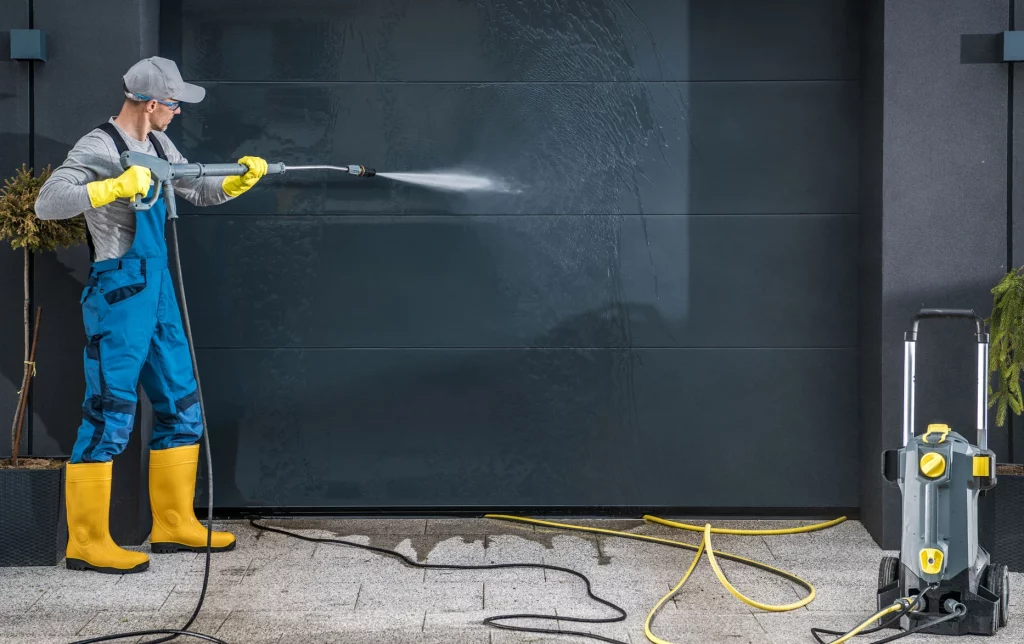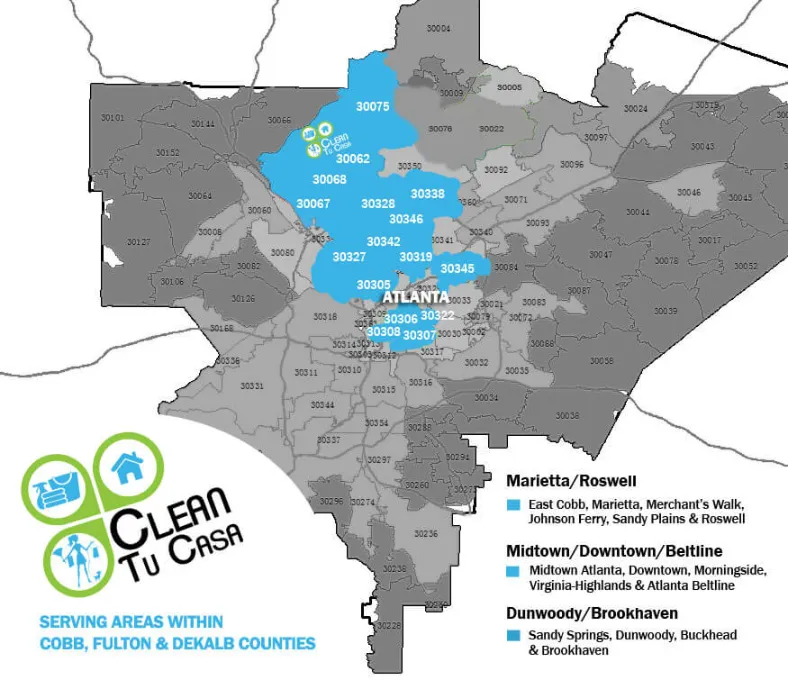Cleaning Tips
Published On
The Power of Pressure Washing: A Complete Guide for Homeowners
Written By
Pressure washing is sometimes called pressure cleaning or power washing. No matter what you call it, it involves using a high-pressure stream of water to remove dirt, grime, stains, mold, and other contaminants from various surfaces. Not only does pressure washing instantly enhance the appearance of your home, but it also contributes to its overall maintenance and value.
When you pressure wash certain areas of your home (such as the curb, driveway, walkway, walls, etc.), it instantly levels up your home's appearance, which is especially important if you want to put your home on the market. Pressure washing a house before putting it on sale has been found to increase its market value by about 5-10%.
Pressure washing is great for other reasons too. It is environmentally friendly, using less water than you would if you cleaned your home manually. It also helps maintain your home as it prevents damage and lowers the frequency of repairs.
If you’re looking for details on how to pressure-wash your house, its benefits, areas of your home that are pressure-washer friendly, and so on, you have come to the right site.
Related: 6 Important Tips for Cleaning Outdoor Living Spaces
The Benefits Of Pressure Washing
- It improves the appearance of your home
The exterior of your home is exposed to the elements all year round, so the accumulation of stains, dirt, and grime is inevitable. However, the power of pressure washing lies in its ability to transform a weathered and grimy exterior into a pristine and inviting space. The high-pressure stream effectively removes dirt, dust, and stains, revealing the true beauty of your home's surfaces.
- Prevents long-term damage on surfaces
As earlier stated, the build-up of dirt and grime is inevitable. However, if this build-up is allowed to linger, it can cause long-term damage to your surfaces. This is because it begins to eat away at your wood, concrete, and vinyl surfaces, leading to damage in the long run.
- Improves health
Contaminants such as allergens can accumulate on the surfaces of your home leading to a reduction in the air quality in and around your home. It could also lead to possible health challenges. Power washing, however, gets rid of these contaminants.
- Helps to prime surfaces
Pressure washing is very helpful to prime the surfaces around your home, such as the walls and fences, in anticipation of work being done on them.
Before you repaint your home and other exterior surfaces, use a pressure washer to remove the dirt build-up on them, allowing for a fresh canvas. This makes your paint job last longer.
Also, in cases where you want to sand down the paint on any of your surfaces, pressure washing prior significantly cuts down the amount of time you have to spend.
- Maintains high property value
A good home maintains and even increases in value over time. Howbeit, it is said that first impressions matter, and this is especially true in the world of real estate. No one wants to buy a house that appears rundown or to be in poor condition.
Even though your home might be wonderful on the inside, a shabby-looking exterior would prevent people from wanting to even come close, not to mention inspecting the house. On the other hand, a pristine exterior provides an inviting and welcoming atmosphere for potential buyers.
Precautions to Take while Using a Pressure Washer

Before we dive into surfaces you can pressure wash in your home, it is essential to learn what to do and what not to do to ensure your safety while using a pressure washer.
Here is a list of necessary safety precautions;
- Never goof around with your pressure washer: A pressure washer differs from your regular garden hose. You might be tempted to turn it on somebody to hose them down. Don’t! The pressure of the water is very potent. It can tear skin and even cause blindness if it gets into the eyes.
- Keep away from children: This goes without saying. When using a power washer, make sure to keep children away. It could injure them, some of the injuries possibly being permanent. Keep children engaged in other activities inside the house when a pressure washer is used outside.
- Beware of electricity: Water and electricity are a terrible combination. Seal any outdoor outlets with duct tape to prevent water from getting into them. Be wary of overhead power lines as well. You wouldn’t want an electrical disaster on your hands.
- Wear safety goggles: While using the power washer, particles and debris from the surface being washed could fly out and end up in your eye. This is a prevalent hazard, occurring more often than not. Always wear safety goggles for eye safety.
- Stay away from ladders: If your home is taller than one story and you need to pressure wash it, get a professional. If you want to do it yourself, hire/rent a lockable wheel scaffolding. Never use a ladder alongside a power washer. The recoil from the power washer could fling you right off the ladder.
- Grip the hose with both hands: Always grip the hose of your pressure washer firmly. The pressure and recoil could make it fly out of a loose grip. This could damage any nearby object or injure anyone passing.
Another critical thing to note is the manufacturer’s instructions. Make sure to read through and understand it before using the pressure washer.
8 Places You Can Pressure Wash In Your Home
Not all surfaces are meant for a pressure washer. That includes fragile surfaces and surfaces on the inside of your house. Here are surfaces you can pressure wash and what you need to get that done.
- Driveways and Walkways
Driveways and walkways are mostly made of concrete or stone. Stains and build-up are very obvious on these materials. To pressure-wash driveways, you’ll need your pressure washer set at a very high pressure. The steps for washing any concrete surfaces are as follows;
- Sweep the surface thoroughly before you start.
- Pre-treat surfaces with obvious stains, such as grease or oil spillage, by scrubbing those areas with a concrete cleaning solution.
- Use a narrow spray nozzle like the rotary spray nozzle for your pressure washing.
- Seal the concrete afterward for an elongated life.
- Sidings and Exteriors
For the exterior of your house, power washing can take care of mold, mildew, and algae. You will need a high-pressure stream for surfaces like brick but a lower-pressure stream for painted surfaces coated with old paint. If the paint contains lead, don’t pressure wash as this releases lead particles into the air.
Dulling and mildew are common with siding, especially vinyl, but pressure cleaning can fix that. Here are the steps you need;
- Inspect the entire siding and patch up any breaches before you start.
- Pretreat any especially dirty areas by scrubbing with a brush to loosen the dirt.
- Fill the pressure washer's detergent reservoir with soap and use the soap nozzle for your cleaning.
- Rinse the soap with a high-pressure stream of water.
- Decks and Patio
Power washing gives your patio and wooden decks a new life altogether. For your patio, you need to be careful not to remove the joint sand, and you also need to reseal after washing. You also need to be careful with your wooden decks because if the water pressure is too high, it could lead to wood damage from splintering. Make sure to stain afterward.
- Fences and Gates
Pressure washing also applies to your fences and gates, irrespective of whether they are metal or wooden. Some fence cleaning tips for your wooden fences and gates- start with a lower water pressure to avoid damage. You can increase the pressure as you go if you notice that the wood can handle it. Stain the wood afterward where necessary.
- Outdoor Furniture
The fall months are almost here, which means your patio chairs will soon be going into storage. Pressure washing can uplift the look of your outdoor furniture, especially after a long time in storage. However, you need to be careful if they are made of wood to prevent damage.
- Garage Doors and Floors
Your garage floors most likely have stains from oil, tire marks, and scuffing from some of the things you store in there. Pressure washing on a very high setting can take care of those stains. You can remove stubborn stains by scrubbing with a surface cleaner before your pressure wash.
- Gutters
Clogged and discolored gutters can be very hard to look at while also causing expensive damage. You can pressure wash them to restore and clean them out, giving your home an impeccable appearance. This also applies to soffits.
- Pool Decks
Pools can be full of pool chemicals, bacteria, and mud. Over time it might begin to look unappealing, but it’s nothing that a little poolside pressure washing can’t take care of. A soft pressure wash with specialized brushes and surfactants can make your pool deck look as good as new without damaging it.
Pressure Washing Frequency And Timing

How often should you pressure wash your house? The answer is at least once a year. This depends heavily on the location of your home and its subsequent exposure to the elements. Therefore, houses in heavily populated and coastal areas should be pressure washed every six months.
Late spring or the beginning of fall is the best time to pressure wash your home. The optimum weather prevents your home from getting dirty shortly after. You can also schedule a pressure wash just before placing your house on the market.
Diy Vs. Professional Pressure Washing
You might be faced with the dilemma of choosing between DIY pressure washing and hiring a professional company. Here is a comparison to help you make a choice.
| DIY | PROFESSIONAL |
| Less expensive | More expensive |
| Lower quality of results | Higher quality of results because of experience |
| Takes a significant amount of time and effort | No time or effort required |
| Improper use of equipment could pose a safety hazard | No risk of injury from misusing equipment |
| Could damage surfaces because of incorrect use | No damage to surfaces as they know the needs of each specific area |
In the end, it all boils down to the size and difficulty of the cleaning job. If the area to be cleaned is extensive and requires a high level of expertise, such as in tall buildings, simply hire a professional company.
Conclusion
Pressure washing has a lot of benefits when it comes to maintaining and improving the aesthetics of your home, preventing long-term damage, improving the health of your household, and increasing the market value of your property. And whether you decide to hire a professional company or do it yourself, it is an option worth considering.
Clean Tu Casa is the team to call for any cleaning service in Atlanta. We offer Atlanta residential cleaning services and corporate cleaning services. We provide commercial cleaning services in Marietta, Buckhead, and Brookhaven areas. Whether you want a one-time, weekly, bi-weekly, or monthly cleaning, simply reach out to us for your free quote today.
